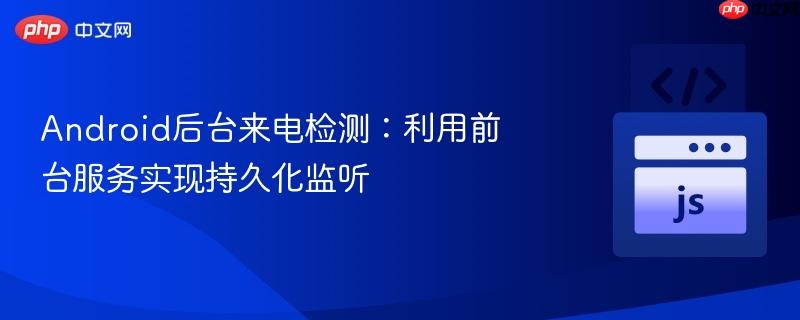
本文详细阐述了如何在 android 应用中,即使应用完全关闭,也能像 Truecaller 那样可靠地检测到来电。核心解决方案是利用 Android 的前台服务(Foreground Services),结合开机启动广播接收器,实现来电状态的持久化监听,并提供了关键代码示例和注意事项,确保应用在后台稳定运行。
在 Android 开发中,实现即使应用完全关闭也能持续监听来电状态的功能,是许多实用 工具 类应用(如来电显示、骚扰拦截)的核心需求。直接在后台运行普通服务或使用传统广播接收器往往会受到系统资源限制,尤其是在较新版本的 Android 系统中,后台进程的管理日益严格,导致应用在完全关闭后无法有效检测到来电。为了解决这一挑战,Android 提供了前台服务(Foreground Services)机制,它允许应用执行用户可见的、持续性任务,从而规避了部分后台执行限制。
一、理解前台服务(Foreground Services)
前台服务是一种特殊类型的服务,它被认为是用户正在主动意识到的操作。当服务被提升为前台服务时,系统会要求它显示一个持续的通知,使用户知道应用正在后台运行。这不仅提高了透明度,也向系统表明该服务对用户很重要,因此系统会更倾向于保持其运行,即使在内存紧张的情况下。
前台服务适用于以下场景:
二、实现后台来电检测的关键步骤
要实现应用在完全关闭后仍能检测到来电,主要涉及以下几个核心组件和步骤:
- 所需权限声明: 在 AndroidManifest.xml 中声明必要的权限。
- 开机启动广播接收器: 监听系统开机完成事件,在设备启动后自动启动服务。
- 前台服务实现: 创建一个前台服务,其中包含 TelephonyManager 和 PhoneStateListener 来监听电话状态。
- 持续通知: 前台服务必须伴随一个持续的通知。
2.1 声明必要权限
在 AndroidManifest.xml 文件中,需要声明以下权限:
- READ_PHONE_STATE:用于读取手机状态和识别来电。
- FOREGROUND_SERVICE:用于将服务提升为前台服务。
- RECEIVE_BOOT_COMPLETED:用于接收设备开机完成广播,以便在开机后启动服务。
<manifest xmlns:android="http://schemas.android.com/apk/res/android" package="com.example.calldetector"> <uses-permission android:name="android.permission.READ_PHONE_STATE" /> <uses-permission android:name="android.permission.FOREGROUND_SERVICE" /> <uses-permission android:name="android.permission.RECEIVE_BOOT_COMPLETED" /> <application …… <service android:name=".CallDetectionService" android:enabled="true" android:exported="false" /> <receiver android:name=".BootReceiver" android:enabled="true" android:exported="true"> <intent-filter> <action android:name="android.intent.action.BOOT_COMPLETED" /> <category android:name="android.intent.category.DEFAULT" /> </intent-filter> </receiver> </application> </manifest>注意: 对于 READ_PHONE_STATE 权限,在 Android 6.0 (API level 23) 及更高版本上,这属于危险权限,需要在运行时动态向用户请求。
2.2 实现开机启动广播接收器
创建一个 BroadcastReceiver 来监听 ACTION_BOOT_COMPLETED 广播,并在接收到该广播时启动 CallDetectionService。
// BootReceiver.java package com.example.calldetector; import android.content.BroadcastReceiver; import android.content.Context; import android.content.Intent; import android.os.Build; import android.util.Log; public class BootReceiver extends BroadcastReceiver {private static final String TAG = "BootReceiver"; @Override public void onReceive(Context context, Intent intent) {if (Intent.ACTION_BOOT_COMPLETED.equals(intent.getAction())) {Log.d(TAG, "Boot completed, starting CallDetectionService."); Intent serviceIntent = new Intent(context, CallDetectionService.class); if (Build.VERSION.SDK_INT >= Build.VERSION_CODES.O) {// For Android O and above, use startForegroundService context.startForegroundService(serviceIntent); } else {context.startService(serviceIntent); } } } }2.3 实现前台服务
CallDetectionService 将是核心组件,它负责监听电话状态并处理来电事件。
// CallDetectionService.java package com.example.calldetector; import android.app.Notification; import android.app.NotificationChannel; import android.app.NotificationManager; import android.app.Service; import android.content.Context; import android.content.Intent; import android.graphics.Color; import android.os.Build; import android.os.IBinder; import android.telephony.PhoneStateListener; import android.telephony.TelephonyManager; import android.util.Log; import androidx.annotation.Nullable; import androidx.core.app.NotificationCompat; public class CallDetectionService extends Service {private static final String TAG = "CallDetectionService"; private static final String CHANNEL_ID = "CallDetectionChannel"; private static final int NOTIFICATION_ID = 101; private TelephonyManager telephonyManager; private PhoneStateListener phoneStateListener; @Override public void onCreate() {super.onCreate(); Log.d(TAG, "Service onCreate"); // 初始化电话管理器和监听器 telephonyManager = (TelephonyManager) getSystemService(Context.TELEPHONY_SERVICE); phoneStateListener = new PhoneStateListener() { @Override public void onCallStateChanged(int state, String phoneNumber) {super.onCallStateChanged(state, phoneNumber); switch (state) {case TelephonyManager.CALL_STATE_IDLE: Log.d(TAG, "Call State: IDLE - No call activity."); // 电话挂断或空闲 break; case TelephonyManager.CALL_STATE_RINGING: Log.d(TAG, "Call State: RINGING - Incoming call from: " + phoneNumber); // 来电响铃 // 在这里处理来电逻辑,例如显示来电信息、播放提示音等 break; case TelephonyManager.CALL_STATE_OFFHOOK: Log.d(TAG, "Call State: OFFHOOK - Call answered or dialing."); // 电话接通或拨出 break; } } }; } @Override public int onStartCommand(Intent intent, int flags, int startId) {Log.d(TAG, "Service onStartCommand"); // 创建并显示前台通知 createNotificationChannel(); Notification notification = new NotificationCompat.Builder(this, CHANNEL_ID) .setContentTitle(" 来电检测服务 ") .setContentText(" 正在后台运行,检测来电状态……") .setSmallIcon(android.R.drawable.ic_menu_call) // 使用系统图标作为示例 .setPriority(NotificationCompat.PRIORITY_LOW) .build(); startForeground(NOTIFICATION_ID, notification); // 注册电话状态监听器 if (telephonyManager != null) {telephonyManager.listen(phoneStateListener, PhoneStateListener.LISTEN_CALL_STATE); } // 返回 START_STICKY 表示如果服务被系统杀死,系统会尝试重新创建它 return START_STICKY; } @Override public void onDestroy() { super.onDestroy(); Log.d(TAG, "Service onDestroy"); // 在服务销毁时,取消注册电话状态监听器,防止内存泄漏 if (telephonyManager != null) {telephonyManager.listen(phoneStateListener, PhoneStateListener.LISTEN_NONE); } } @Nullable @Override public IBinder onBind(Intent intent) {// 对于不与 Activity 绑定的服务,返回 null return null;} private void createNotificationChannel() { if (Build.VERSION.SDK_INT >= Build.VERSION_CODES.O) {NotificationChannel serviceChannel = new NotificationChannel( CHANNEL_ID, " 来电检测通知 ", NotificationManager.IMPORTANCE_LOW); serviceChannel.setDescription(" 用于显示来电检测服务正在后台运行的通知。"); serviceChannel.enableLights(true); serviceChannel.setLightColor(Color.BLUE); NotificationManager manager = getSystemService(NotificationManager.class); if (manager != null) {manager.createNotificationChannel(serviceChannel); } } } }代码说明:
- onCreate(): 初始化 TelephonyManager 和 PhoneStateListener。PhoneStateListener 的 onCallStateChanged 方法是核心,它会在电话状态(空闲、响铃、通话中)改变时被调用。
- onStartCommand():
- 这是服务的主要入口点。在这里,我们创建并显示前台通知,这是将服务提升为前台服务的关键一步。
- startForeground(NOTIFICATION_ID, notification) 方法将服务置于前台。
- 注册 phoneStateListener 来监听电话状态。
- 返回 START_STICKY 确保服务在被系统杀死后能被 自动重启。
- onDestroy(): 在服务被销毁时,务必取消注册 PhoneStateListener,以避免内存泄漏。
- createNotificationChannel(): 对于 Android 8.0 (API level 26) 及更高版本,必须为通知创建通知渠道。
三、注意事项与最佳实践
- 运行时权限请求: READ_PHONE_STATE 权限是危险权限,在 Android 6.0 (API level 23) 及更高版本上,需要在应用首次启动时或尝试使用该功能时,通过 ActivityCompat.requestPermissions() 动态向用户请求。如果用户拒绝,服务将无法正常工作。
- 用户体验与通知: 前台服务必须显示一个持续的通知。这个通知应该清晰地告知用户应用正在做什么。通知的优先级应根据实际需求设置,通常对于后台持续任务,IMPORTANCE_LOW 或 PRIORITY_LOW 是合适的选择,避免过度打扰用户。
- 电池消耗: 尽管前台服务比普通后台服务更稳定,但持续运行的监听器仍然会消耗一定的电池。应确保在不需要监听时(例如用户在应用设置中关闭了该功能),能够停止服务并取消监听。
- 服务生命周期管理: 确保服务的启动和停止逻辑清晰。例如,除了开机启动,用户也可以通过应用界面手动启动或停止服务。在服务停止时,务必解除所有注册的监听器和释放资源。
- Android 版本兼容性: 随着 Android 版本的迭代,后台执行策略和权限管理可能会有变化。例如,Android 9 (Pie) 引入了对非前台应用访问电话信息的一些限制,Android 10 (Q) 对后台位置访问有了更严格的控制(尽管这里主要关注电话状态)。在开发时应测试不同版本的兼容性。
- 错误处理: 在注册监听器或获取 TelephonyManager 时,应考虑空 指针 异常或权限不足的情况,并进行适当的错误处理。
四、总结
通过利用 Android 的前台服务,并结合开机启动广播接收器和 PhoneStateListener,开发者可以有效地实现在应用完全关闭后仍能可靠地检测到来电。这种方法不仅解决了传统后台服务在系统限制下的不稳定性问题,也通过强制显示通知提高了应用的透明度,符合 Android 系统对后台任务的管理规范。在实际开发中,除了核心功能实现,还需重视用户体验、权限管理和电池优化,以提供一个稳定、高效且用户友好的来电检测应用。



